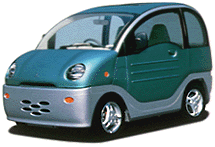|
|
|
A number of improvements are being made to the typical gasoline-burning cars that most people use. Among the gasoline-burning cars in Japan, the light car - which is defined as having an engine of 660 cc or less - is quite popular. There are also even smaller cars, called micro-compact cars, which consume a very small amount of gasoline and fit into a very small parking space. Low-emission vehicles, meanwhile, are cars designed to reduce emissions of harmful substances, like carbon monoxide and hydrocarbons. This is done either by producing smaller amounts of these substances or by refining the exhaust gas.
At the same time, there are other cars that do not use gasoline at all. Some run on fuels like natural gas or methanol and produce very few harmful emissions. There are also hybrid vehicles, which run on a combination of a gasoline-powered engine and an electric motor. Then there are zero-emissions vehicles - cars that run entirely on electricity.
Gasoline is produced from petroleum, which is made up of the remains of plants and animals from long ago that have decayed over time. It is believed that the world will eventually run out of petroleum, so these new types of cars are very important.
Photo: Mitsubishi Motors Corp.

